There is good news for those working in the world of DVD and game audio post. Not only are consumers snapping up DVD players and the latest gaming consoles at a swift pace, producers are allowing musicians, sound designers and mixers a heightened level of creativity.
In the DVD market specifically, many post houses are seeing a boom in demand for audio services for new offerings as well as for some of studios' older catalogs that need to be revamped for eventual DVD release.
Alan Ett, of Alan Ett Music Group and Media City Sound, points out that new opportunity means a substantial amount of work.
"A lot of product exists that now needs to be prepared for the DVD format, which ends up meaning remixing things that were originally in stereo - promos, trailers, whatever products and elements exist that have not been mixed in surround or prepared for DVD," he says. "Now we have the opportunity and the mandate to go back and rethink that. As formats change we all know that becomes opportunity for us. It's a problem for the broadcasters and the distributors, and it's an opportunity for us."
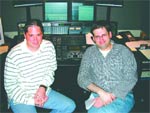
New Wave Entertainment's Chris Colley and Jeffrey Lerner (L-R) recently completed work on the Harry Potter and the Chamber of Secrets DVD.
|
Likewise, the audio post market for games is seeing a resurgence, especially as new gaming consoles boast better sound and picture capabilities. Where sound designers and composers used to have to worry about oppressive compression rates, nowadays consoles can play audio formatted up to surround sound and have more memory so sound effects and design can be more detailed and nuanced.
To be sure, this is one of the bright spots in an audio post market that's struggling along with the rest of the economy.
Let's take a look at some recent projects. . .
INVOKING AN EMOTIONAL RESPONSE
Award-winning composer Billy Martin of Laguna Hills, CA's Billy Martin Music (www.billymartinmusic.com) has been busy with a number of videogame titles for Disney and Ubisoft, which he considers on par with composing work he's done for television or film. "I'm trying to invoke an emotional response in a listener that will pull them into a story they're watching or listening to," he says. The main difference, he adds, is that instead of composing to a picture, he's writing to a character performing an action. "So, you have to tailor the music so it will fit into all of those areas. Sometimes that's by writing one long piece of music that plays throughout or writing several small pieces that are triggered by some action that a player does during a game that makes you switch to a new piece. Hopefully that is done in a manner that is seamless or at least not jarring."
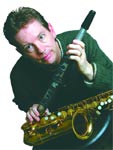
Composer Billy Martin considers his game work on par with film and TV projects he's worked on.
|
To get that done, Martin relies on TASCAM's GigaStudio as well as a handful of hardware samplers that will eventually all be replaced by computer samplers. He's using Steinberg's Cubase SX for sequencing, and a Mackie 24-8 console. Martin is able to get an intimate musical feel while working on computers by adding organic instruments. "I made my living as a woodwind player, so I'll often play a flute part or a sax part or a little clarinet on anything that I'm doing. Even if it's not the main melody it really helps the group come alive," he explains. "I try to liven up anything that I work on and whenever budget allows I'll bring in additional players to give it that human element."
Martin has been impacted by composing for games because of the limits on cue lengths and not on resolutions. "Music used to get squashed down to lower resolutions a lot, mono 22K or worse, but most of the time the music is CD quality," he points out. "Most of the consoles can put out a Dolby Surround Sound mix now. So, as far as sound quality, the music is pretty good and I'm sure the next console generation will be indistinguishable from anything else." And there is the challenge of working within the sound design of a game. "You have to be aware of what kind of sound effects are going to be in," he reports. "In a game there will be areas that play like a cinematic movie, but there will be other areas [that] you might want to stay out of. You might want to leave some space and do a lot of high stuff that's going to cut through, or if you're going to use the lower area, have some big hits that hit hard but are then out of the way."
CONQUERING 27 FOREIGN LANGUAGES
According to senior producer Jeffrey Lerner and re-recording mixer Chris Colley, the team at LA's New Wave Entertainment (www.newwaveent.com) is busy working on DVD featurettes, commentary and menu mixing, as well as post assignments for games and DVD-ROM material. New Wave recently completed the work on Harry Potter and the Chamber of Secrets. The main challenge for the Potter project, Colley reports, was that he worked on a total of 27 foreign language translations. The key to getting that done, in addition to many extra hours of work, was pre-mixing a consistent set of sonic beds. "Then we tailored each one to every individual language, because some languages are faster or slower than English," Lerner explains. The key was consistency, Colley adds, from version to version as well as all of the value added pieces within the DVD.
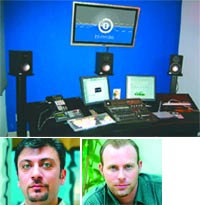
B1 Media's new 5.1 surround sound suite. Inset are executive producer Brian Johnson (right) and creative director Benjamin Zev (left).
|
All of the sound menu items were delivered to New Wave via .Wav files, including the Jim Dale narration that was recorded in New York and then sent through ISDN to New Wave's Los Angeles facility. "After we received the ISDN, Chris and his team broke it down into .Wav files that were going to be individual assets, because it needed to be labeled for each particular function happening on the disc," Lerner reports. New Wave uses the Fairlight DREAM consoles for all of its audio post work.
"I think that for the voiceover alone there had to have been over 500 files just for the English," Colley recalls. After the audio was prepped, the files were sent to the menu design house and integrated into the DVD's menus and games. "Once they got that to a point where they were approved by Warner Bros. they would send me splits of the files so I would have voiceover, separate sound effects, separate music and I was supposed to mix them all together," he explains. "At that point I made .Wav files out of everything else and did a stereo mix of all that stuff and then bounced it down to .Wav files. Then the .Wav files are QC'd and uploaded to a Web site for final approval." While the DVDs are released in surround sound and New Wave receives files in LT/RT, the majority of their work is done in stereo.
EMBRACING SHOCKWAVE
 |
Mark Cohn, executive producer at Blitz Digital Studios (www.blitzDS. com) in LA, reports that in addition to the company's array of 3D and animation services they've been busy pushing the market of Shockwave online games. "We've been working on some things to raise the bar, because we feel with Shockwave you can do a lot more than what's currently out there," he says. The move to Shockwave, and away from Flash, has enabled the company to be more creative. "We've done a few Flash games and there's usually 500K for the entire audio for it," he says. "The challenge is in writing a piece of music that is very short but doesn't get boring. So, we try to be sneaky about how things fade in and out. I'm pretty excited about Shockwave because we'll have Direct X and be able to do more interactive music - music that changes based on the action in the game." For the work that Blitz has done, including a Scooby-Doo online game, the team has relied on Logic Audio, Digidesign Pro Tools and the TASCAM GigaStudio.
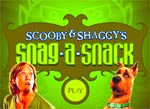
Blitz relies on Logic Audio and Pro Tools for online games like this Scooby-Doo-themed one.
|
What makes the audio post assignments a bit easier for Blitz is that they are controlling both the visual and audio. "Usually nobody saves enough space for the audio because they want to squeeze in as much of the visual as possible," he explains. "But we control that. The audio is almost like putting a puzzle together, because there's this balance of having things not repetitive and annoying, but still keeping the file size very small." One thing that Blitz has done to conserve file space is to take one sound effect and then pitch bend it so it will work as three different effects. "Or there's different program ability by getting into the DSP hardware of the cards so you can actually control reverb and delay times dynamically," Cohn adds. "That helps by not having to make several different versions of sound effects by doing it programatically."
Working on games that play on the Internet provides an especially intimidating set of challenges, Cohn reports. "The biggest challenge for doing it on the Web is that you can never see it altogether until it's all on the site," he says. "When you're doing post for something linear like an animation, obviously you're watching it and you can be very controlled about the imaging and where you're placing things in the environment." Flash-based programs, on the other hand, are very event based. "You trigger something and nothing really locks. So, when you're overlaying things you can never tell how it's going to be until it's done. You have to do everything five times, and you have to know through experience how things are going to go."
SOUND FOR A MORE DISCERNING CONSUMER
When LA's B1 Media (www.b1media.-com) opened its doors, the company was primarily involved with graphics. Then sound designer and mixer Phillip Kovats joined the staff and the company started to look at adding audio to their array of services. In January of this year, the company opened a 5.1 surround audio suite boasting Pro Tools HD, where Kovats has worked on a number of DVD projects - menus and featurettes - that have come through the door. "B1 has done a lot of titles in the past and they pushed the envelope to make things interesting. When they brought me on board, the idea was to bring that mission to life soundwise," Kovats says. "It's fun for me, because it's a whole creative environment. Some of the DVDs I've heard, the menu stuff is pretty bland and generic."
In addition to Pro Tools HD, the new B1 room features a handful of mixing, mastering and sound design plug-ins. A bevy of sound effects - in the neighborhood of 40,000 - are stored and accessed via Gallery's mTools SFX Database System.
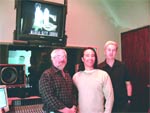
(L-R): Media City Sound's Alan Ett, Erik Valenzuela and Dan Snow.
|
From what he's seen, Kovats believes the DVD market is strong. "People are becoming a little more sophisticated in what they like," he reports. "I think DVDs are on the upswing." And consumers will be hearing better things, thanks to improved sample and bit rates. "The audio technologies that are being pushed will give you a lot more headroom, a lot more warmth and a lot more ability to make clear, crisp sound. I think as the price of [home] surround systems comes down, you'll have more consumers who know what they want to get and what they can expect."
As an example of just that, Kovats recalls working on a featurette for the DVD release of the second Lord of the Rings movie. "While I was working on that, the guys were going in and remixing the DVD specifically for home theaters," he says. "I think people expect more now, and as a lover of movies and a lover of audio I want to push where we're heading."
LEVERAGING ALL YOUR ASSETS
Studio City, CA's Media City Sound (www.mcsound.com), along with its sister companies Alan Ett Music Group and the Opus 1 Music Library, has the ability to offer an array of services for companies looking to boost their catalog of DVDs. Media City Sound continues to perform services on DVD trailers for all of the studios under the Buena Vista umbrella, including Miramax, Dimension and Disney. "Buena Vista made a decision to have their DVDs be in 5.1 surround from start to finish," explains Media City's operations manager, Dan Snow. "I think it's a great call as a company. All the trailers, title cards, all the menus are in 5.1."
Media City Sound recently remixed in 5.1 trailers for the DVD releases of Chicago, Gangs of New York, Who Framed Roger Rabbit? and A Bug's Life.
"One of the good things about the combination of companies we have here is that we do have the capability of supplying music resources as well," adds Alan Ett. "When Buena Vista went with the DVDs in 5.1, we created new logos for them with 5.1 surround treatments of effects and music that they are now using on all their DVD releases."
In addition to those services, Media City Sound records commentary tracks included on DVDs. That responsibility falls to sound engineer Erik Valenzuela. To record those tracks, Valenzuela uses Sennheiser 416 microphones recorded directly to Pro Tools through an Otari Status 18R board. "Sometimes I might compress them a little bit with a Drawmer," he explains, "because some people project more than others." That said, the challenges that Valenzuela faces day to day include the number of people included in a commentary session and where those people face during the session. "Sometimes they are looking at the screen and talking and sometimes they are looking at each other, and sometimes their small talk is interesting," he says. "But positioning of the mic is important."
Media City Sound is faced with balancing ongoing time and budget constraints along with increased demand. They solve that by having a talented crew and using creative solutions through each of their three companies.
"The old triangle of fast, cheap or good no longer exists," Ett admits. "It has to be all three of those. The interaction among our companies helps financially in that we can do things in one company and benefit another company. Somebody might come to us and have no budget for the mix, but have a music budget. So, we'll roll it all up together and have a package that makes sense for us and for the client. We have the flexibility of doing that. Also, we're in Los Angeles, so we have access to a wealth of talent."